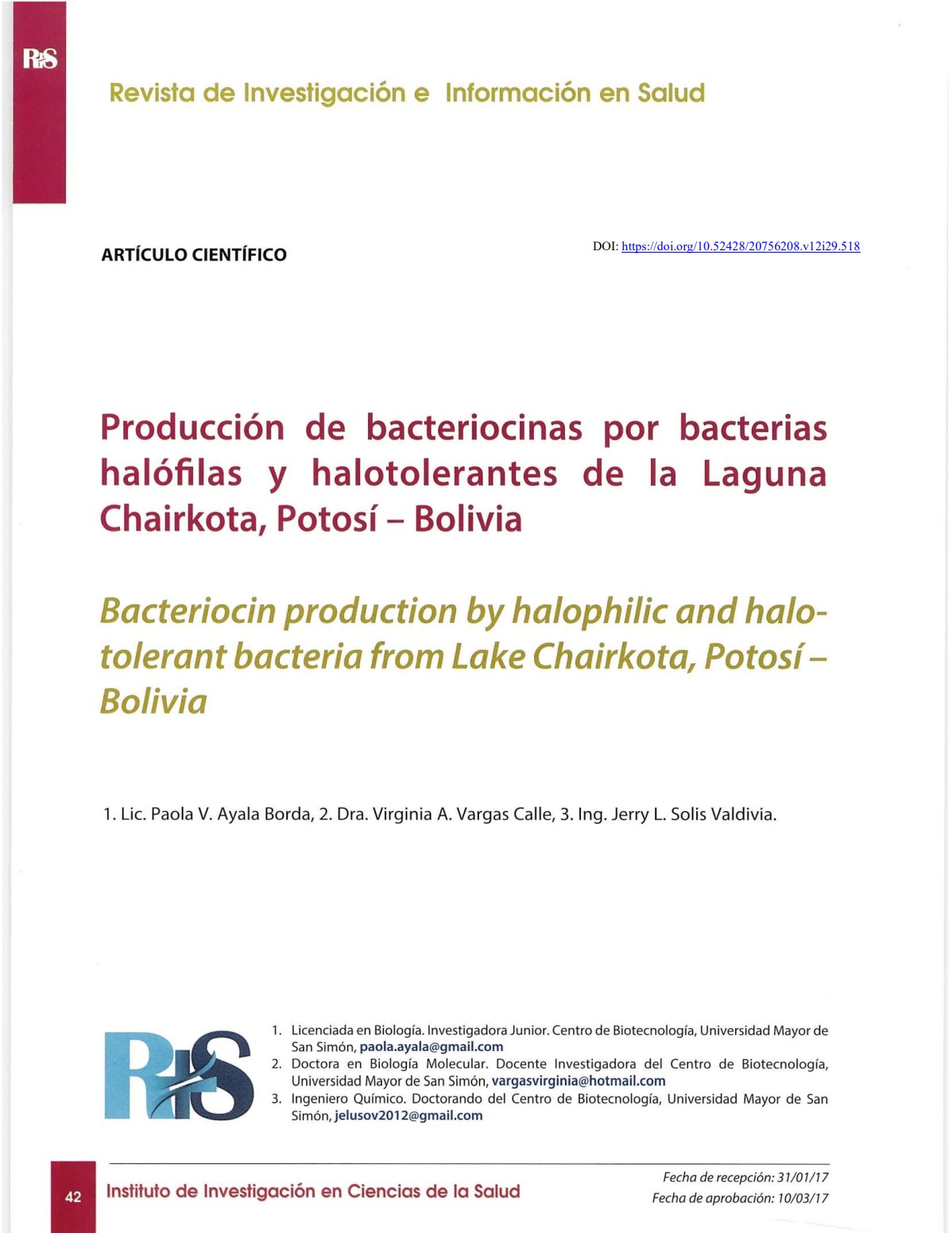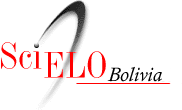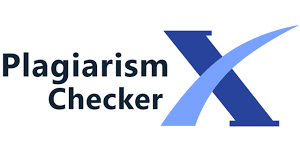Bacteriocin Production by Halophilic and Halotolerant Bacteria from Lake Chairkota, Potosí Bolivia
DOI:
https://doi.org/10.52428/20756208.v12i29.518Keywords:
Halophilic bacteria, Bacteriocins, Staphylococcus equorum, Bolivian AltiplanoAbstract
En las últimas décadas se ha estudiado extensamente la capacidad de las bacterias halófilas de producir sustancias de interés biotecnológico. El Centro de Biotecnología de la Universidad Mayor de San Simón cuenta con un banco de microorganismos halófilos aislados del altiplano boliviano, de los cuales se seleccionó 71 cepas halófilas y halo tolerantes de la Laguna Chairkota para analizar su capacidad de producción de sustancias antibióticas o bacteriocinas. Se realizó un screening de las cepas en medio de cultivo sólido, utilizando la técnica de la doble capa, y se encontró 14 cepas capaces de producir bacteriocinas. Posteriormente se seleccionó a la cepa halo tolerante CH20 como mejor productora que al ser secuenciada, analizada filogenéticamente y caracterizada morfológica y bioquímicamente. Se encontró que pertenece a la especie Staphy/ococcus equorum, especie descrita en bibliografía, aislada de medios con alto contenido de sal. Se denominó a la cepa identificada como Staphylococcus equorum CH20. Esta investigación demuestra la capacidad biotecnológica de los microorganismos halófilos. Especialmente el potencial que tienen las cepas aisladas del altiplano boliviano, las cuales pueden ser utilizadas en un futuro como alternativa a los antibióticos comúnmente comercializados.
Downloads
References
1. VAN DEN BURG, B. Extremophiles as a source for novel enzymes. Current Opinion 1n Microbiology. 2003. 6: 213 - 218. https://doi.org/10.1016/S1369-5274(03)00060-2
2. RILEY, M. A. AND WERTZ, J. E. Bacterloctn diversity: ecological and evolutionary perspectives. Biochimie. 2002. 84:357-64. https://doi.org/10.1016/S0300-9084(02)01421-9
3. JACK R. W., TAGG, J. R. ANO RAY, B. Bacteriocins of Gram- positive bacteria. Microbio! Rev. 1995. 59:171- 200. https://doi.org/10.1128/mr.59.2.171-200.1995
4. CHEN, H. ANO HOOVER, D.G. Bacteriocins and their Food Applications. Comprehensive Reviews in Food Science and Food Safety. 2003. 2:82-100. https://doi.org/10.1111/j.1541-4337.2003.tb00016.x
5. MOLL, G.N., KONINGS, W. N. and ORIESSEN, A. J. M. Bacteriocins: mechanism of membrane insertion and pore formation. Antonie van Leeuwenhoek. 1999. 76: 185 - 198. https://doi.org/10.1007/978-94-017-2027-4_8
6. QUILLAGUAMÁN J., DELGADO, 0., MATTIASSON, B. ANO HATTI-KAUL, R. Chromohalobacter sarecensls sp. nov., a psychrotolerant modera te halophile isolated from the salme Andean region of Bolivia. lnternational Journal of Systematic and Evolutionary Microbiology. 2004. 54: 1921-1926. https://doi.org/10.1099/ijs.0.63153-0
7. ARAGAO, R. Actividad antimicrobiana de bacterias halófilas y halotolerantes del altiplano boliviano. Tesis de grado para obtener el Diploma Académico de Licenciatura en Biología. Universidad Mayor de San Simón. Cochabamba - Bolivia. 2006.
8. ATANASOVA, N.S., PIETILÁ, M. K. ANO OKSANEN, H.M. Diverse antrmicrobíal interactions of halophilic archaea and bacteria extended over geographical distances and cross the domaln barrier. Microbiology Open. 2013. 2(5): 811 - 825. https://doi.org/10.1002/mbo3.115
9. AZEMIN, A., KLAPPA, P. ANO OMAR, M.S.S. Bacteriocin isolated from Halomonas sp.: a bacteria! DING protein? The Malaysian Journal of Analytical Sciences. 2015. 19(4): 831 - 840.
10. BISCOLA, V., TODOROV, S.D., CAP UANO, V.S.C., ABRIOUEL, H., GÁLVEZ, A. ANO FRANCO, B.D.G.M. lsolation and charactenzatlon of a nlstnhke bactenocm produced by a Lactococcus lactis strain isolated from charqui, a Brazilian fermented, salted and dried meat product. Meat Science. 2013. 93: 607 - 613. https://doi.org/10.1016/j.meatsci.2012.11.021
11 . JEONG, D.W., HAN, S. ANO LEE, J.H. Safety and technological characterization of Staphylococcus equorum isolates from jeotgal, a Korean high-salt-fermented seafood, far starter development. lnternational Journal of Food Microbiology. 2014. 188: 108 - 115. https://doi.org/10.1016/j.ijfoodmicro.2014.07.022
12. SÁNCHEZ-PORRO, C., MELLADO, E., BERTOLDO, C., ANTRANIKIAN G. ANO VENTOSA, A. Screening and characterization of the proteaseCPl produced by the moderately halophilic bacterium Pseudoalteromonas sp. Strain CP76. Extremophiles. 2003. 7: 221 - 228. https://doi.org/10.1007/s00792-003-0316-9
13. NOVÁKOVÁ, O., SEOLÁ(EK, l., PANT0(EK, R., )TETINA, V., )VEC, P. ANO PETRAS, P. Staphylococcus equorum and Staphylococcus su ccinus isolated from human clinical specimen. Journal of medical Microbiology. 2006. SS: 523 - 528. https://doi.org/10.1099/jmm.0.46246-0
14. SADFI-ZOUAOU!, N., ESSGHAIER, B., HAJLAOUI, M. R., FARDEAU, M. L., CAYAOL, J. L., OLLIVIER, B. ANO BOUDABOUS, A. Ability of Moderately Halophilic Bacteria to Control Grey Mould Drsease on Tomato Fruits. Journal of Phytopathology. 2008. 156: 42 - 52. https://doi.org/10.1111/j.1439-0434.2007.01329.x
15. ANAND, T. P., BHAT, A. W., SHOUCHE, Y. S., ROY, U., SIDDHARTH, J. ANO SARMA, S. P. Antimicrobial activity of marine bacteria associated with sponges from the waters of the coast of South East India. Microb,ological Research. 2006. 161 (3): 252 - 262. https://doi.org/10.1016/j.micres.2005.09.002
16. CARN!O, M.C., HÓLTZEL, A., RUDOLF, M., HENLE, T., JUNG, G. AND SCHERER, S. The Macrocyclic Peptide Antibiotic Micrococcin P1 is Secreted by the Food-Borne Bacterium Staphylococcus equorum WS 2733 and lnhibits Listeria monocytogenes on Soft Cheese. 2000. 66(6):2378-2384. https://doi.org/10.1128/AEM.66.6.2378-2384.2000
17. CARNIO, M.C., STACHELHAUS, T., FRANCIS, K. P. ANO SCHERER, S. Pyridinit polythiazole class peptide antibiotic micrococcin Pl, secreted by foodborne Staphylococcus equorum WS2733, is biosynthesized nonribosomally. Eur. J. Biochem. 2001. 286: 6390 - 6400.
https://doi.org/10.1046/j.0014-2956.2001.02591.x
18. KHOUITI, z. AND SIMON, J. P. Detection and partial characterization of a bacteriocin produced by Carnobacterium piscicola 213. Journal of Industrial Microbiology & Biotechnology. 1997. 19: 28 - 33. https://doi.org/10.1038/sj.jim.2900412
19. JACK, R., WAN, J, GOROON, J., HARMARK, K., DAVIDSON, B. E., HILLIER, A. J., WETTENHALL, R. E. H., HICKEY, M. W. ANO COVENTRY, M. J. Characterization of the Chemical and Antimicrobial Properties of Piscicolin 126, a Bacteriocin Produced by Carnobacterium piscicola JGl 26.Applied and Environmental Microbiology. 1996. 62(8): 2897 - 2903. https://doi.org/10.1128/aem.62.8.2897-2903.1996

Downloads
Published
How to Cite
Issue
Section
License
Copyright (c) 2017 Paola V. Ayala Borda, Virginia A. Vargas Calle y Jerry L. Solis Valdivia

This work is licensed under a Creative Commons Attribution 4.0 International License.
Authors who publish with this journal agree to the following terms:
- Authors retain copyright and grant the journal right of first publication with the work simultaneously licensed under a Creative Commons Attribution License 4.0 that allows others to share the work with an acknowledgement of the work's authorship and initial publication in this journal.
- Authors are able to enter into separate, additional contractual arrangements for the non-exclusive distribution of the journal's published version of the work (e.g., post it to an institutional repository or publish it in a book), with an acknowledgement of its initial publication in this journal.
- Authors are permitted and encouraged to post their work online (e.g., in institutional repositories or on their website) prior to and during the submission process, as it can lead to productive exchanges, as well as earlier and greater citation of published work.






















